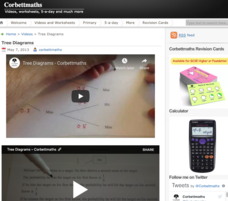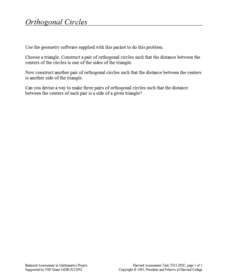Corbett Maths
The Mode
Most frequently prefer the mode. The resource defines the mode and shows how to determine it in a data set. Using another type of problem, the video develops a data set with a given mode and number of data points.
Corbett Maths
Angle Bisector
Cut it in half with a compass and straightedge! Using construction tools, a video shows how to create an angle bisector. The presenter points out what it means to bisect an angle in terms of the measure and distances from the sides of...
Corbett Maths
Constructing SSS Triangles
Creating a triangles is as easy as 5, 6, 7. Using a ruler and compass to measure off lengths, a short video shows how to construct a triangle with three specific side lengths. The example creates a triangle with side lengths of 5 cm, 6...
Corbett Maths
Constructing SAS Triangles
Two sides and an angle ... a triangle it makes. Given the measure to two sides and the angle between them, the narrator of a short video shows how to draw a triangle with a ruler and protractor. Pupils use handouts to practice the newly...
Corbett Maths
Enlargements with Negative Scale Factor
How will a scale factor affect a figure—negatively? Using a grid, the narrator of an engaging video performs a dilation with a negative scale factor. The presenter compares a positive scale factor with a negative scale factor to explain...
Corbett Maths
Constructing ASA Triangles
The narrator of a short video explains the steps in constructing a triangle given the measure of two angles and the length of the side between the angles. The resource provides opportunities for pupils to practice the skill with two...
Corbett Maths
Perpendicular from a Line to a Point
Take steps in the right direction. With a short demonstration, a video shows the steps to construct a perpendicular from a line to a point. Using a protractor, the narrator confirms the resulting construction is perpendicular, and then...
Corbett Maths
Perpendicular Through a Point on a Line
Use one construction to complete a second. The short video shows how to incorporate the steps of a perpendicular bisector to create a perpendicular to a point on a line. With their own straightedges and compasses, classmates then...
Corbett Maths
Perpendicular Bisector
Where should the statue be located? The resource explains how to use a compass and straight-edge to construct the perpendicular bisector of a line segment. Using an exam question, the narrator models how to solve an application problem...
Corbett Maths
Enlargements Using Ray Method
Figure out what to do when there is no grid to count. Using a ruler and a sharp pencil, the narrator shows how to perform a dilation when the figure is not on a grid. The ray method works by drawing a ray from the center of dilation...
Corbett Maths
Enlargements with Fractional Scale Factors
Enlargements make it bigger, right? A video shows viewers how to perform a basic dilation with a fractional scale factor. They learn how to use the scale factor to find the location of the transformed vertex by multiplying the horizontal...
Corbett Maths
Finding the Centre of Enlargement
Where did the transformation begin? Using a ruler, the narrator of a short presentation shows how to find the center of enlargement for transformed figures. Worksheets provide the class members an opportunity to practice the newly...
Corbett Maths
Describing Enlargements
What caused that to happen? Using three aspects, a video demonstrates how to describe an enlargement or dilation. The presenter counts the lengths of the sides to determine the scale factor and a ruler to find the center of dilation.
Corbett Maths
Enlargements
Count on the scale to enlarge a figure. The video shows how to create an enlargement given a scale factor and a center of enlargement. The presenter multiplies the vertical and horizontal distance by the scale factor to find the new...
Concord Consortium
Full of Beans
Scholars have an opportunity to use their geometric modeling skills. Pupils determine a reasonable estimate of the number of string beans that would fill the average human body.
Corbett Maths
Inverse Proportion
Take an indirect view of proportionality. Using a similar approach of direct variation, the resource shows how to solve inverse proportions. The video steps through finding the constant of proportionality to write the formula for the...
Corbett Maths
Direct Proportion
Direct change by finding the constant. Using two known values within a direct proportion, the resource shows how to find the constant of proportionality. Once individuals do that, they then find any value given the other. The video works...
Corbett Maths
Listing Outcomes
Make a list and check it twice. Many times, it is beneficial to make a list of the possible outcomes when trying to determine a probability. The resource shows how to systematically make a list and then calculate the probability of...
Corbett Maths
Tree Diagrams
Climb out on a branch to find probabilities. Using tree diagrams, the resource shows how to find compound probabilities when the events are not uniform. The video works through two different scenarios, one where the probabilities remain...
Corbett Maths
Pythagoras Rectangles and Isosceles Triangles
When does the Pythagorean Theorem come in handy? An intriguing video uses the Pythagorean Theorem to solve problems other than simply finding the length of a side of a right triangle. Pupils find the diagonal of a rectangle and the...
Corbett Maths
3D Pythagoras
Calculate one hypotenuse then repeat. The resource provides a variety of ways for finding the length of the diagonal in a prism. Using the Pythagorean Theorem, pupils find a variety of distances in 3-D figures. The distances range from...
PBS
Scale City — Scaling up Recipes and Circles in the Real World
What a great big skillet you have. The resource introduces the class to the world's largest stainless steel skillet. The class creates a model of the skillet and a typical 12-inch skillet and compares the relative sizes of their areas....
Council for Economic Education
Calculating Simple Interest
How much is owed? A calculated resource introduces the simple interest formula with a video that describes how to use it. Classmates then show what they know by answering questions within a simple interest worksheet.
Concord Consortium
Orthogonal Circles
Here's some very interesting circles for your very interested pupils. A performance task requires scholars to sketch a pair of orthogonal circles so the centers are the endpoints of one side of a triangle. They draw an additional circle...

























